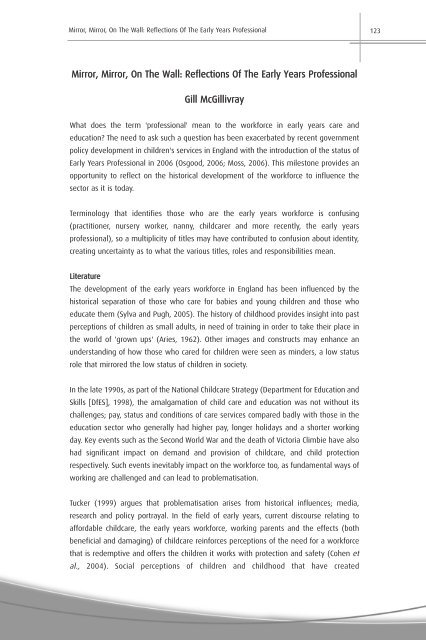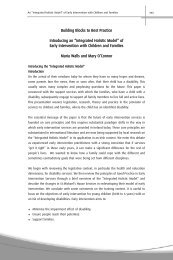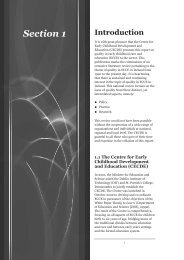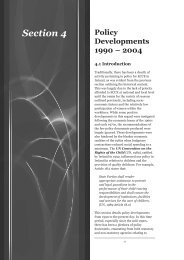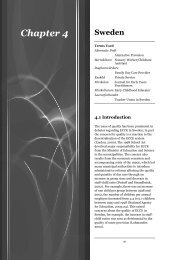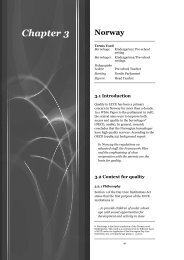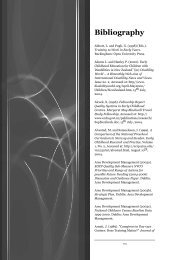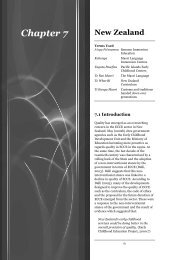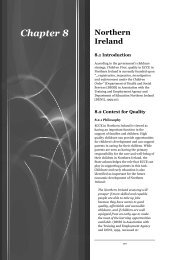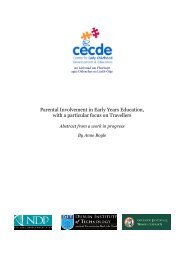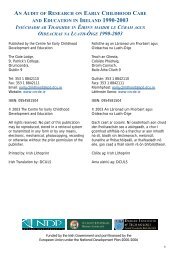Visions 08 sec 2.qxd - Centre for Early Childhood Development ...
Visions 08 sec 2.qxd - Centre for Early Childhood Development ...
Visions 08 sec 2.qxd - Centre for Early Childhood Development ...
- No tags were found...
Create successful ePaper yourself
Turn your PDF publications into a flip-book with our unique Google optimized e-Paper software.
Mirror, Mirror, On The Wall: Reflections Of The <strong>Early</strong> Years Professional 123Mirror, Mirror, On The Wall: Reflections Of The <strong>Early</strong> Years ProfessionalGill McGillivrayWhat does the term 'professional' mean to the work<strong>for</strong>ce in early years care andeducation? The need to ask such a question has been exacerbated by recent governmentpolicy development in children's services in England with the introduction of the status of<strong>Early</strong> Years Professional in 2006 (Osgood, 2006; Moss, 2006). This milestone provides anopportunity to reflect on the historical development of the work<strong>for</strong>ce to influence the<strong>sec</strong>tor as it is today.Terminology that identifies those who are the early years work<strong>for</strong>ce is confusing(practitioner, nursery worker, nanny, childcarer and more recently, the early yearsprofessional), so a multiplicity of titles may have contributed to confusion about identity,creating uncertainty as to what the various titles, roles and responsibilities mean.LiteratureThe development of the early years work<strong>for</strong>ce in England has been influenced by thehistorical separation of those who care <strong>for</strong> babies and young children and those whoeducate them (Sylva and Pugh, 2005). The history of childhood provides insight into pastperceptions of children as small adults, in need of training in order to take their place inthe world of 'grown ups' (Aries, 1962). Other images and constructs may enhance anunderstanding of how those who cared <strong>for</strong> children were seen as minders, a low statusrole that mirrored the low status of children in society.In the late 1990s, as part of the National Childcare Strategy (Department <strong>for</strong> Education andSkills [DfES], 1998), the amalgamation of child care and education was not without itschallenges; pay, status and conditions of care services compared badly with those in theeducation <strong>sec</strong>tor who generally had higher pay, longer holidays and a shorter workingday. Key events such as the Second World War and the death of Victoria Climbie have alsohad significant impact on demand and provision of childcare, and child protectionrespectively. Such events inevitably impact on the work<strong>for</strong>ce too, as fundamental ways ofworking are challenged and can lead to problematisation.Tucker (1999) argues that problematisation arises from historical influences; media,research and policy portrayal. In the field of early years, current discourse relating toaf<strong>for</strong>dable childcare, the early years work<strong>for</strong>ce, working parents and the effects (bothbeneficial and damaging) of childcare rein<strong>for</strong>ces perceptions of the need <strong>for</strong> a work<strong>for</strong>cethat is redemptive and offers the children it works with protection and safety (Cohen etal., 2004). Social perceptions of children and childhood that have created
124Vision into Practiceproblematisation <strong>for</strong> the early years work<strong>for</strong>ce include early years care as genderconstructs such as 'women's work' (Moss, 2003). A tension arises from the dichotomybetween a work<strong>for</strong>ce that is construed as caring, maternal and gendered, as opposed toprofessional, highly trained, well qualified and equal to teachers and nurses.Tucker (2004: 84) proposes that any framework that examines professional identityshould be able to:"assist analysis of those <strong>for</strong>ms of discourse that are used to define particular <strong>for</strong>ms ofwork; show how ideas are struggled over and contested at various levels ofexperience; and demonstrate how such matters directly impact upon the professionalidentities which individuals and groups adopt in their everyday work".In addition, Tucker (2004) offers a framework <strong>for</strong> analysis that identifies factors involvedin the construction of professional identity (see Figure 1). Such factors are helpful inbeginning to develop lines of enquiry <strong>for</strong> this research, and recur in Ellis and Whittington(1988) and Eraut (1994).Figure 1. Factors involved in the construction of professional identity (Tucker 2004: 88)Use of ideological effects toshape the discourse of the'official' (through socialpolicy etc) to determine thepotential 'treatment' ofchildrenLink between prevailingdiscourses andcontemporary priorities andpracticesProfessionalidentitiesDynamic tension between'macro' and 'micro' levelsroles,relationshipsexpectationsInfluence of trainingchangingcurriculumobjectives and methods ofassessment
Mirror, Mirror, On The Wall: Reflections Of The <strong>Early</strong> Years Professional 125Eraut (1994) identifies the training and education that typifies professions, such as aperiod of time <strong>for</strong> learning the 'trade' and enrolment on specialist training courses. Theincrease in <strong>Early</strong> <strong>Childhood</strong> Studies degree courses available at Higher EducationInstitutions reflects the wider opportunities now available <strong>for</strong> training and developmentat higher levels <strong>for</strong> the early years work<strong>for</strong>ce.Some key themes emerging from literature relating to professional identity wereterminology (related to what name the work<strong>for</strong>ce is known by); social policy and theeconomy and its impact on childcare and education (thus the work<strong>for</strong>ce too); training,qualifications, education and continuing professional development; and issues of gender,status, power and relationships.MethodologyDocumentary analysis offered potential as a research method to explore text in thecontext of the above themes and prevailing discourses at different points in time. Fealy(2004) undertook discourse analysis relating to nurses in Ireland. He revealed how thepublic discourse was influenced by culture and socio-political influences, from his analysisof nursing periodicals from the 1920s to the 1980s. Fealy (2004: 649) sought text relatingto "what nurses were doing and saying, including evidence of professional debate." Thismethod offered a line of enquiry in the search <strong>for</strong> equivalent discourse relating to earlyyears professionals. Language used in the context of the early years work<strong>for</strong>ce set in achronological context could illustrate changes in policy development."Discourse is a <strong>for</strong>m of power exercised by particular social groups; discourse decides'who' speaks and what they say, <strong>for</strong> no one has the right to say anything. …Hencepower and knowledge are joined. As social practices put knowledge to work, it is thediscourses that produce truth" (Swingewood, 2000: 197).Sources that provided historical documentary evidence of discourse pertinent to the earlyyears work<strong>for</strong>ce were selected, with the aim of asking the following key questions of thedocuments:1. What terms are used to identify members of the early years work<strong>for</strong>ce (who are notteachers)?2. What levels of training, qualifications, type of employment, knowledge,understanding and skills and personal qualities are explicit or implicit within thedocuments?3. What discourse relates to status, gender and power?DiscourseIt became apparent that the sources located <strong>for</strong> the earlier decades had scant mention ofthe early years work<strong>for</strong>ce, other than teachers. Such a paucity suggests an invisibility, and
126Vision into Practicethat the children who were receiving care and education did so from an anonymouswork<strong>for</strong>ce, and thus there are implications <strong>for</strong> its identity.Table 1 below shows terms used to identify the work<strong>for</strong>ce in texts.Table 1. Terms used to describe the work<strong>for</strong>ceDecade1950s1960s1970s1980s1990s2000sTerminologyNursery school helperNursery assistantsNursery matron, childminders, qualified nursery nurses, NNEB trained personnel, nurserynursesAdults, other adult staff, nannyThose working with young children, workers, professionals, nursery staff, staff, thoseworking with under fives, nannyPractitioners, nursery nurses, day nursery workers, early years work<strong>for</strong>ce, early yearsprofessionals, pedagogues, 'new' teachersThe range of terms presented in Table 1 suggests change, ambiguity and uncertainty. Ifthe terms used are considered in a chronological context, changes can be traced inresponse to key policy developments: the post World War 2 emphasis on mothers stayingat home to care <strong>for</strong> their children; the expansion of nursery education in the 1970s; theNational Childcare Strategy emerging at the end of the 1990s preceded by MargaretThatcher's nursery voucher scheme; to the current work<strong>for</strong>ce re<strong>for</strong>m. Terms become morevaried, general and generic, encompassing those members of the work<strong>for</strong>ce who may beworking in a voluntary or unqualified capacity. In the 2000s, new terms are introducedthat have not been used be<strong>for</strong>e such as 'pedagogue'. Such breadth in an attempt to beinclusive could also create uncertainty. The Children's Work<strong>for</strong>ce consultation (DfES, 2005)sought views on 'pedagogue' or 'new teacher' models: the title <strong>Early</strong> Years Professionalwas the outcome, rejecting both.Searching <strong>for</strong> textual discourse on issues related to being a professional (training,qualifications, status, personal and professional qualities, gender) identified in theliterature provided additional insight. Table 2 indicates views held by academics,researchers, policy writers and others on such issues.
Mirror, Mirror, On The Wall: Reflections Of The <strong>Early</strong> Years Professional 127Table 2. Discourse on Issues Related to being a ProfessionalDecade1940s1960s1970sText"Women were carefully chosen <strong>for</strong> their personal and practical experience of themothering of young children. Where possible they were womenfolk who had hadchildren of their own, and whose children were growing up." (Stross, 1946: 701)"The status and salary <strong>for</strong> aides and nursery assistants would be superior to that ofwelfare and meals assistants." (Plowden, 1967: 331)"You are responsible and practical, with a sense of humour and a real liking <strong>for</strong> children- the naughty ones as well as the sweeties" and "It is a student's temperament thatcounts, along with good sense." (Elias, 1972: 14)"They are not grasping money (no-one gets prosperous on illegal minding);…they areproviding a sadly necessary but very low-grade service." (Jackson, 1973: 523)"Some concern has been felt about the adequacy of existing courses <strong>for</strong> work which call<strong>for</strong> maturity, special skills and more than a little knowledge of child development andfamily relationships." (Kellmer Pringle and Naidoo, 1975: 132)1980s "Are you kind, loving, sympathetic and yet firm with young children?" (Turnor, 1984: 9)"Too often the nursery nurse issue is swept under the carpet …Nursery nurses host acluster of grievances, both real and imagined, and imposed and self-inflicted." (Heaslip,1987: 34)1990s2000s"We cannot ignore the importance of training as a source of in<strong>for</strong>mation and ideas aboutchild development and pedagogic techniques appropriate <strong>for</strong> children aged under five."(Osborn and Millbank, 1987: 45)"She must be warm and outgoing and sensitive to the needs of others. Coexisting withher maturity there must be a childlike relish <strong>for</strong> the joy of playing." (Henderson andLucas, 1989: 96)"A view exacerbated by differences in pay and conditions of employment betweenqualified teachers and permanent day nursery staff." (Audit Commission, 1996: 69)"The standards of training and qualifications should remain high at each stage. Workingwith young children is a complex and demanding task - it requires a team ofprofessionals who are appropriately trained to adopt a variety of roles andresponsibilities." (Ball, 1994: 58)"We need to do more to ensure that working with children is seen as an attractivecareer, and improve skills and inter-professional relationships. Many of those who workwith children ….feel undervalued, and in some cases under siege" (DfES, 2003: 22)"Working with pre-school children should have as much status as a profession asteaching children in schools" (HM Treasury, 2004: 4)Repeated demand <strong>for</strong> improved training and qualifications structure since the 1970s stillremains and rein<strong>for</strong>ces a sense of lack of action and strategy in addressing the need toimprove training, qualifications and career structure <strong>for</strong> the early years work<strong>for</strong>ce overpast decades. Gender is inextricably tied into the early years work<strong>for</strong>ce: if the work<strong>for</strong>ceis largely made up of women, some of whom will be mothers, is there inherent tensionbetween the role of caregiver to a child whose mother has left to go to work, and therole of mother who should be at home to bring up her children (Cohen et al., 2004)?Themes relating to personal qualities are the need to be maternal, sensitive,knowledgeable, to have an inherent 'talent' and almost to have childlike qualities
128Vision into Practicethemselves in order to be an effective worker. It could be concluded that prior to recenttimes, assumptions were made that it was only necessary to have such inherent qualitiesand be a mother to become a member of the work<strong>for</strong>ce and not to be able to meet anyother pre-requisites (Fealy, 2004).ConclusionWhat has discourse revealed in terms of insight into the professional identity of the earlyyears work<strong>for</strong>ce? The definition of what a professional is suggests that it requires a highlevel of training and education. This is an aspiration that is only now becoming within thegrasp of the early years work<strong>for</strong>ce. The unheeded demand <strong>for</strong> improved status andtraining however suggest voices unheard.Invisibility may also be sustained through lack of voice and presence in policy anddiscussion. Power and knowledge are implicit in the discourse presented in this research.Changes over time reveal knowledge that ranges from subversion (illegal minding) toresentment (having grievances about relative status compared to teachers, <strong>for</strong> example),to being expected to have a liking <strong>for</strong> children and play in order to become a practitioner.Siraj-Blatch<strong>for</strong>d (1993) cites the vulnerability of women, the influence of media andmodern misconceptions as exacerbating factors in the lack of status of early years work.Some (Liddle 2006) believe that being an early years practitioner is the same as being aparent, and is dismissive of the need to promote the status and training of the work<strong>for</strong>ce.It could be argued that a struggle is emerging and the power to bring about change lieswith the work<strong>for</strong>ce and its supporters.ReferencesAries, P. (1962). Centuries of <strong>Childhood</strong>. London: Cape Publishing.Audit Commission (1996). Under Fives Count. Management Handbook. London: TheAudit Commission.Ball, C. (1994). Start Right. The Importance of <strong>Early</strong> Learning. London: Royal Society<strong>for</strong> the Encouragement of Arts, Manufactures and Commerce.Cohen, B., Moss, P., Petrie, P. and Wallace, J. (2004). A New Deal <strong>for</strong> Children? Bristol:The Policy Press.Department <strong>for</strong> Education and Employment (1998). Meeting the Childcare Challenge.London: The Stationery Office.
130Vision into PracticeOsborn, A. F. and Millbank, J. E. (1987). The Effects of <strong>Early</strong> Education. Ox<strong>for</strong>d: ClarendonPress.Osgood, J. (2006). Deconstructing Professionalism in <strong>Early</strong> <strong>Childhood</strong> Education: Resistingthe Regulatory Gaze. Contemporary Issues in <strong>Early</strong> <strong>Childhood</strong>, Vol. 7, No. 1, pp. 5 - 14.Plowden, B. (1967). Children and Their Primary Schools. London: HMSO.Siraj-Blatch<strong>for</strong>d, I. (1993). Educational Research and Re<strong>for</strong>m: Some Implications <strong>for</strong> theProfessional Identity of <strong>Early</strong> Years Teachers. British Journal of Educational Studies, Vol. 41,No. 4, pp. 393 - 4<strong>08</strong>.Stross, B. (1946). Young Children (Care and Education). Parliamentary Debates 6thDecember. Hansard. Fifth Series, Vol. 431.Swingewood, A. (2000). A Short History of Sociological Thought. Basingstoke: Palgrave.Sylva, K. and Pugh, G. (2005). Trans<strong>for</strong>ming the <strong>Early</strong> Years in England. Ox<strong>for</strong>d Review ofEducation, Vol. 31, No. 1, pp. 11 - 27.Tucker, S. (1999). Making the Link: Dual 'Problematisation', Discourse and Work withYoung People. Journal of Youth Studies, Vol. 2, No. 3, pp. 283 - 295.Tucker, S. (2004). Youth Working: Professional Identities Given, Received or Contested? (in)Roche, J., Tucker, S., Thomson, R. and Flynn, R. (Eds.) Youth in Society. 2nd ed. London:Sage Publications.Turnor, M. (1984). So You Want to be a Nannie? Nursery World, 24th May, 1984.


